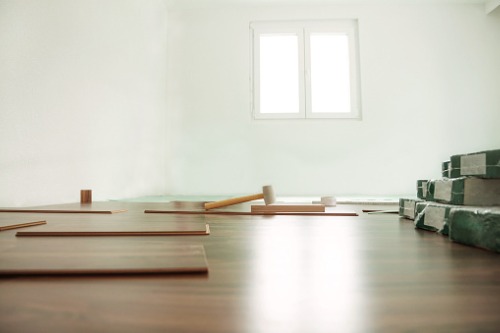Believe it or not, choosing the right flooring can make or break your fix and flip design, as well as its rental potential and attractiveness to tenants

There are many areas to focus on in fix and flips including remodel and redesign. One of the most valuable elements to pay attention to is flooring. Your return on investment (ROI) could greatly increase by updating flooring resulting in a highly profitable project.
The challenge is what type of materials to use to attract the best buyer possible. Using the wrong materials can bring down your property value while potentially sacrificing your asking price when buyers don’t like the choices you made.
Lynk Capital offers some savvy decision options for your rehab property’s floors using great-looking, inexpensive materials.
Hardwood flooring
“The best flooring for any residential property is hardwood flooring,” said Lynk. “Hardwoods can not only stand the test of time for durability, but they continue to increase in popularity and give your property a classic and modern look.” This type of combination results in typically higher resale values in your investment. When in doubt, go with hardwood. “They’re universally preferred and here to stay,” said Lynk.
By adding hardwood floors, Realtor.com suggests that you could increase your sales price up to 2.5% depending on location, buyer expectations, square footage, and layout.
Quality hardwoods are expensive, however, and aren’t going to fit into every flipper’s budget. Luckily, there are several alternatives to hardwood that still get a great ROI.
Engineered Hardwoods
The best alternative to traditional hardwood flooring is engineered wood flooring. These are offered in a variety of colors, styles, and textures to mimic the appeal and warmth of traditional hardwood flooring.
“They are great for almost any home, from higher-end to lower price points,” said Lynk.
They are easier to install and have come a long way from the hollow-sounding floating floors seen in past rehabs. “Quality flooring companies have figured this out,” said Lynk. Test different padding or subfloor options as potential buyers will hardly be able to tell you didn’t use real wood.
Tile
Tile is a great option for bathrooms and kitchens because of the moisture and mess that can occur in these areas. Longer and more sophisticated tiles or even tiles made to resemble hardwood floors have a higher performance in these high-traffic areas.
“This can be a big selling point for your listing for active families or buyers with pets,” said Lynk.
Consider what buyers are attracted to in your neighborhood. Are they more prone to seek out a scratch or dent-proof option? Does water damage flooring sound like the desired quality? Tile is your best bet.
Laminate vs. Vinyl
While tile and engineered hardwood may appeal, they too, can be costly. Laminate or vinyl, however, are stand-out options for first-time homebuyer properties or low-cost fix and flip properties. They may not be a great option for high-end renovations, but they have come a long way from the peel-and-stick “tiles” seen in past renovations.
“Now, high-quality laminate, luxury vinyl flooring (LVF) and vinyl composition tile (VCT) can stand up to homebuyers’ standards in certain price points,” said Lynk.
To find the best prices in your fix and flip flooring, be sure to avoid buying small quantities at retail and buy in bulk. Look for remnant sales in your area that include overstock or slightly damaged but still usable materials. Wherever you buy flooring, seek out suggestions and referrals for installation services. Get multiple quotes and do your best to avoid paying a commission fee to the vendor if you aren’t doing the work yourself.



